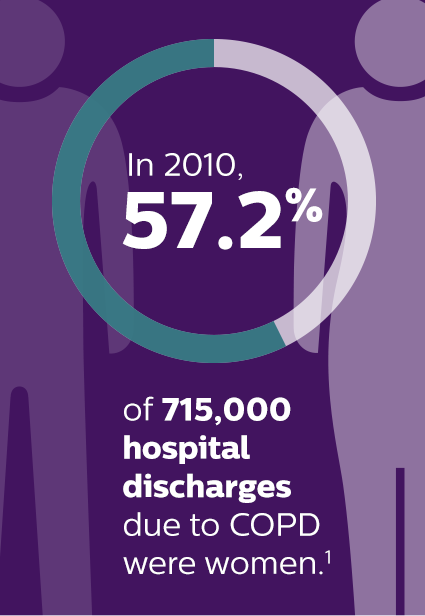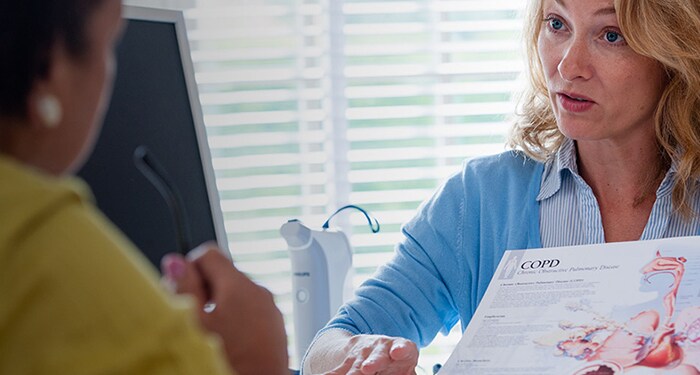Clearing up
misconceptions:
women with COPD
Too often, COPD in women is overlooked or misdiagnosed. In celebration of Women’s Health Month, let’s explore when this misperception began and how you can help overcome it, to spread quality care for all.

Register now for exclusive monthly content like this delivered directly to your inbox
Clearing the air
For countless years, COPD has been looked at as a disease that primarily affects men. But, this misperception couldn’t be further from the truth. More than 7 million women are living with COPD, and millions more remain undiagnosed.1 Additionally, the rate at which women are dying as a result of COPD has been on the rise since 2000.1 So what can you do to help prevent female patients from being overlooked? In honor of Women’s Health Month, let’s take a look back at when COPD became prominent in women and how you can help them get the care they need.
Contributors

Jill Ohar, MD, FCCP
Professor of Internal Medicine, Pulmonary, Critical Care, Allergy, and Immunological Diseases Wake Forest University School of Medicine Director of Clinical Operations Wake Forest University Baptist Medical Center

Brian Carlin, MD, FCCP, FAARC
Critical Care Staff Physician Altoona Regional Health System
A brief look into where women and COPD first crossed paths
During World War II, while men were at war, some women worked in factories where poor ventilation left them constantly breathing in harmful chemicals.2

When the men returned, tobacco use skyrocketed—leaving women susceptible to second-hand smoke.3

Numerous tobacco ads were developed to specifically target women with slogans that emphasized glamour and thinness.1

Tobacco ads were incredibly successful and by 1973 the rate of 12-year-old girls who had started smoking increased by 110%.1

Although the majority of women began smoking later than men, the gap between men and women who die from COPD has rapidly closed.1

Even though a misdiagnosis of asthma in women is a growing problem, perceptions have yet to catch up.1 Here are some tips on how to help you recognize and treat the countless women suffering from COPD.
Ask the right questions
The environment where female patients grew up, occupations they’ve held, or products they’ve used can be critical risk factors for COPD. This is why you need to ask the right questions and get to know your patient’s history.
Some women will deny or diminish their smoking history because growing up their parents may have told them, ‘You shouldn’t smoke.’ So there’s a shame factor that’s attached to them smoking.”
Jill Ohar, MD, FCCP
Professor of Internal Medicine, Pulmonary, Critical Care, Allergy, and Immunological Diseases Wake Forest University School of Medicine Director of Clinical Operations Wake Forest University Baptist Medical Center
True or false:
By the year 2000, COPD had claimed the lives of more women than men1
Perform a spirometry test
Spirometry remains the only recognized method for definitely diagnosing COPD today.4 Although asthma and COPD often present very similar symptoms, this invaluable device may help you rule out asthma as a potential cause. Using a spirometer may enable you to provide an accurate COPD diagnosis in your female patients the first time.
Questions to consider when speaking to your female patients about their symptoms
We need to do a better job diagnosing women with COPD. Too often, providers look at a man and a woman with the same history and assume the woman has asthma.”
Brian Carlin, MD, FCCP, FAARC
Critical Care Staff Physician, Altoona Regional Health System
True or false:
The majority of male and female patients who have COPD symptoms are given a spirometry test to receive an accurate diagnosis.

Build a treatment plan specifically for her
For a treatment plan to work for your female patients, it needs to be tailored to fit specially into their lives. Since women with COPD experience the disease differently than men, they may see different improvements when involved in different programs.1 Take smoking cessation for example. One 5-year study of men and women who quit smoking showed that women experienced nearly twice the improvement in their breathing ability as men in the first year.1
True or false:
Smoking cessation is the single most important disease management strategy available to patients with COPD who still smoke.1
In addition to smoking cessation, pulmonary rehabilitation is an excellent program that may help women reduce the symptoms of COPD.1 Although women do not retain physical improvements as well as men, pulmonary rehabilitation has shown to give women a social support system that encourages them to continue with their treatment. 1
True or false:
Pulmonary rehabilitation is utilized in the majority of COPD treatment plans.
Breathe new life into treating women with COPD
While a difference in diagnosis may exist in women, you can help the COPD care community begin to move past them today. Get to know female patients’ history, use a spirometry test, and build an individualized treatment plan for her and you will be well on your way to providing quality care for all.
Sources: 1. American Lung Association. Taking her breath away: The rise of COPD in women. June 2013. 1-28. 2. My learning website. Women at war: The role of women during WWII. https://www.mylearning.org/women-at-war-the-role-of-women-during-wwii/p-4670/ Accessed February 20, 2017. 3. Burns D, Lee L, Shen L, Gilpin E, Tolley H, Vaughn J, Shanks T. Cigarette Smoking Behavior in the United States. Smoking and Tobacco Control Monography No. 8. 2; 1-100. 4. Spirometry Touted as Best Way to Accurately Diagnose COPD. U.S. Medicine Web site. https://www.usmedicine.com/agencies/department-of-defense-dod/spirometry-touted-as-best-way-to-accurately-diagnose-copd/. Accessed February 20, 2017.






